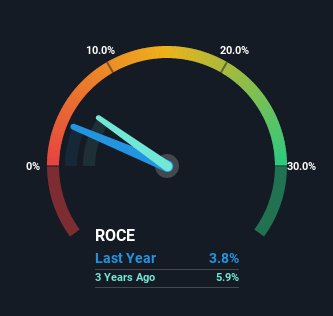- United Kingdom
- /
- Oil and Gas
- /
- AIM:INDI
Returns On Capital Signal Tricky Times Ahead For Indus Gas (LON:INDI)

If we want to find a stock that could multiply over the long term, what are the underlying trends we should look for? Firstly, we'd want to identify a growing return on capital employed (ROCE) and then alongside that, an ever-increasing base of capital employed. Ultimately, this demonstrates that it's a business that is reinvesting profits at increasing rates of return. However, after investigating Indus Gas (LON:INDI), we don't think it's current trends fit the mold of a multi-bagger.
What Is Return On Capital Employed (ROCE)?
Just to clarify if you're unsure, ROCE is a metric for evaluating how much pre-tax income (in percentage terms) a company earns on the capital invested in its business. The formula for this calculation on Indus Gas is:
Return on Capital Employed = Earnings Before Interest and Tax (EBIT) ÷ (Total Assets - Current Liabilities)
0.038 = US$46m ÷ (US$1.2b - US$28m) (Based on the trailing twelve months to September 2021).
So, Indus Gas has an ROCE of 3.8%. In absolute terms, that's a low return and it also under-performs the Oil and Gas industry average of 5.2%.
See our latest analysis for Indus Gas

Historical performance is a great place to start when researching a stock so above you can see the gauge for Indus Gas' ROCE against it's prior returns. If you'd like to look at how Indus Gas has performed in the past in other metrics, you can view this free graph of past earnings, revenue and cash flow.
What Can We Tell From Indus Gas' ROCE Trend?
On the surface, the trend of ROCE at Indus Gas doesn't inspire confidence. Over the last five years, returns on capital have decreased to 3.8% from 6.6% five years ago. Meanwhile, the business is utilizing more capital but this hasn't moved the needle much in terms of sales in the past 12 months, so this could reflect longer term investments. It may take some time before the company starts to see any change in earnings from these investments.
What We Can Learn From Indus Gas' ROCE
Bringing it all together, while we're somewhat encouraged by Indus Gas' reinvestment in its own business, we're aware that returns are shrinking. Since the stock has declined 30% over the last five years, investors may not be too optimistic on this trend improving either. All in all, the inherent trends aren't typical of multi-baggers, so if that's what you're after, we think you might have more luck elsewhere.
Indus Gas does have some risks, we noticed 3 warning signs (and 1 which makes us a bit uncomfortable) we think you should know about.
While Indus Gas may not currently earn the highest returns, we've compiled a list of companies that currently earn more than 25% return on equity. Check out this free list here.
New: AI Stock Screener & Alerts
Our new AI Stock Screener scans the market every day to uncover opportunities.
• Dividend Powerhouses (3%+ Yield)
• Undervalued Small Caps with Insider Buying
• High growth Tech and AI Companies
Or build your own from over 50 metrics.
Have feedback on this article? Concerned about the content? Get in touch with us directly. Alternatively, email editorial-team (at) simplywallst.com.
This article by Simply Wall St is general in nature. We provide commentary based on historical data and analyst forecasts only using an unbiased methodology and our articles are not intended to be financial advice. It does not constitute a recommendation to buy or sell any stock, and does not take account of your objectives, or your financial situation. We aim to bring you long-term focused analysis driven by fundamental data. Note that our analysis may not factor in the latest price-sensitive company announcements or qualitative material. Simply Wall St has no position in any stocks mentioned.
About AIM:INDI
Indus Gas
Through its subsidiaries, engages in the exploration, development, and production of oil and gas in Asia.
Good value slight.
Similar Companies
Market Insights
Community Narratives




